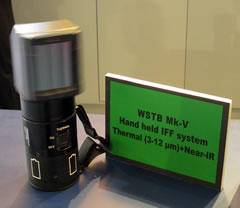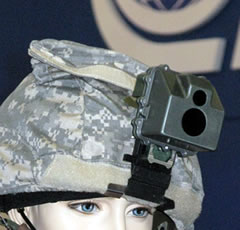Many Integrated Soldier Systems (ISS) were on display, underlining one of the major deficiencies of this new and evolving trend – lack of interoperability and standardization, which unfortunately still retains groups of ‘networked soldiers’ separated in an otherwise, already ‘networked enabled’ environment. While some well equipped soldiers will be able to chat directly with their chief-of-staff, they will still remain unable to talk to a member of a fellow coalition army soldier, wearing his own gear, or borrow a spare battery, to power-up his ‘dead’ radio.
Among the systems on display, were some already operational, including the US Land Warrior system, displayed at the U.S. Army’s Program Executive Office (PEO) Soldier booth and the precursor for the British FIST – known as Enhanced Situational Awareness (ELSA), shown at the Thales display. Other systems are nearing production, primarily the French FELIN shown at the Sagem combined display, slated for initial deployment next year.
Also of interest was the Israeli ‘Advanced Infantry System (AIS)’ scheduled to enter service by 2010. This system was displayed by Elbit Systems. A year later the German MOD is expected to release an order for 939 advanced ISS suites of the IDZ-ES model, shown here by Rheinmetall Defense. The company also demonstrated elements of a suite developed for the Canadian forces while EADS demonstrated a comparable system called Warrior21, in development for Swiss and Spain. In Scandinavia, ISS are currently being developed for the Norwegian and Swedish Armies. These were displayed by the Norwegian company Knogsberg Defense and Saab.
 Auxiliary equipment designed to assist dismounted operations was also in the focus of the exhibition. Among the systems that caught our attention was the MK-V wide spectrum hand-held thermal beacon (WSTB) developed by Thermal Beacon Ltd from Israel. This hand held device is already in service, supporting cooperation between aerial and ground units, operating at night or in conditions where thermal sights are used. MK-V emits an invisible blinking light, visible only to thermal imaging systems (all types are covered – both LWIR, SWIR and NWIR). The unit is visible from a range of 2 km when viewed with 8-12 MCT cameras, or 4-5 km using 3-5 micron equipment. When viewed with light intensifier the device is visible at a range of 10 km.
Auxiliary equipment designed to assist dismounted operations was also in the focus of the exhibition. Among the systems that caught our attention was the MK-V wide spectrum hand-held thermal beacon (WSTB) developed by Thermal Beacon Ltd from Israel. This hand held device is already in service, supporting cooperation between aerial and ground units, operating at night or in conditions where thermal sights are used. MK-V emits an invisible blinking light, visible only to thermal imaging systems (all types are covered – both LWIR, SWIR and NWIR). The unit is visible from a range of 2 km when viewed with 8-12 MCT cameras, or 4-5 km using 3-5 micron equipment. When viewed with light intensifier the device is visible at a range of 10 km.
A different thermal tactical flashlight is offered by OptigO, through its cooperation with parent company Elta Systems of the Israel Aerospace Industries (IAI) group. The Samantha multi-wave thermal flashlight operates in the long- and mid-wave infrared can be used for identification and signaling between forces using thermal imaging equipment. Utilizing directional beam with adjustable beam width, the system can operate effectively overlong distances and used securely while operating behind enemy lines, for search and rescue and other special operations missions, in areas where both friendly and hostile forces are using thermal vision systems.
Power is one of the most critical aspects of all ISS operations, on extended, dismounted missions. Power provisions have already become a main factor in the design of current and future systems, as the battery-load carried by the soldier rapidly matches the other loads of other combat critical supplies, such as ammunition, water and protective armor.
New trends in power systems based on primary batteries, rechargeable cells, and fuel cells, used either as direct power sources, or battery chargers, running on relatively lightweight yet energy-efficient fuels. Such fuel cells are being developed by a number of companies including Ultracell in the USA and EFOY in Germany.
Medis Technologies is another company that has sofar focused on commercial applications of fuel cells, but is introducing a new fuel-cell technology called Power Knight. Contained in a small, flat backpack it is promising up to 72 hours of continuous operation, delivering 20 watt for the individual soldier. A prototype system has already been developed for General Dynamics for evaluation in its future soldier systems program. The company already began producing a commercial version of the system in March 2008.
The following topics are included in our Eurosatory 2008 focus:
-
Integrated Soldier Systems (ISS)
- Unmanned Aerial and Ground Systems (UAV/UGV)



















